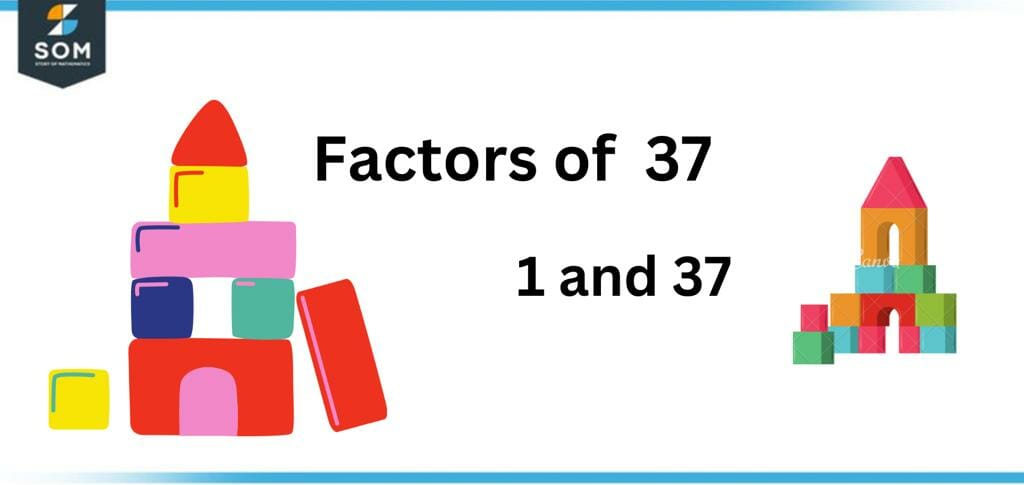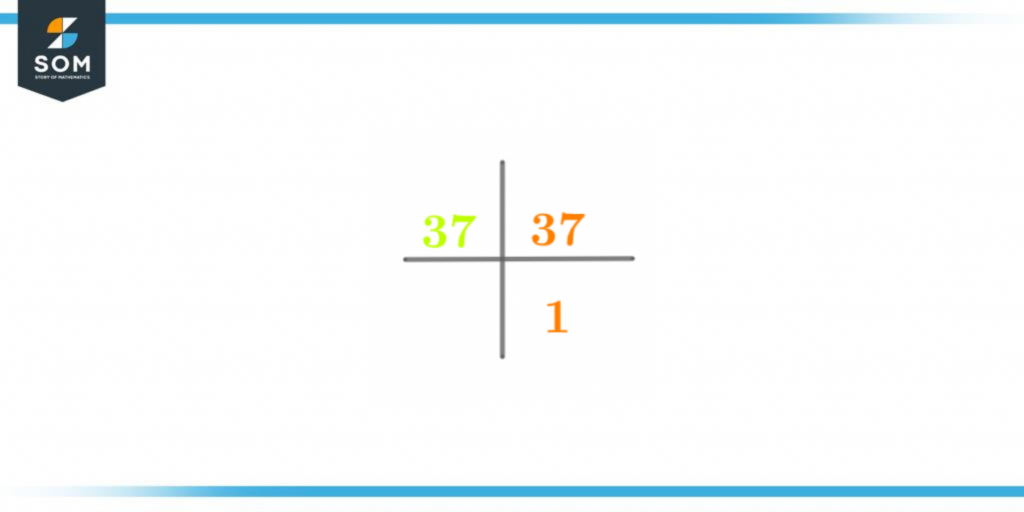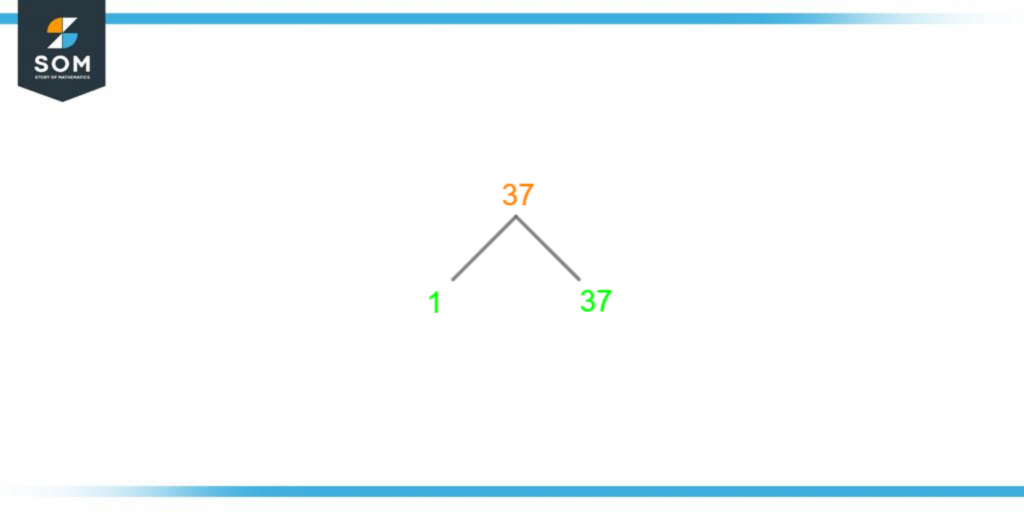JUMP TO TOPIC
Factors of 37: Prime Factorization, Methods, Tree, and Examples
Factorization of 37 will divide it into numbers that can represent 37 when multiplied together. These numbers are called factors of 37. They also produce a remainder equal to zero when 37 is divided by them.

Figure 1 – All possible Factors of 37
These factors can be found through methods mentioned in this article, in which we will discuss mathematical models and visual diagrams for factorization.
What Are the Factors of 37?
The factors of number 37 are 1 and 37. This is because it is a prime number that always has two factors only.
These two factors can be paired into a single factor pair and are both positive and negative.
How To Calculate the Factors of 37?
All factors of 37 can be calculated through prime factorization or division method. But before delving into any of these methods, we should look at the number 37 first. Now 37 is a prime number, it does not have several factors like composite numbers.
Division
Composite numbers have additional factors other than one and the number itself, but that is not the case for prime numbers. They only have two factors, making our problem even more straightforward.
To understand prime factorization, we must understand the division method first:
Step 1: We already know that 37 is a prime number, so we divide it first by one, which is the universal factor:
\[ \frac{37}{ 1} = 37 \]
Step 2: In the second step, we divide it by 37; the number itself for any prime number is always a factor as well.
\[ \frac{37}{ 37} = 1 \]
So the factors of 37 through the division method are:
Factors of prime number 37 = 1 and 37.
Factors of 37 by Prime Factorization
Prime factorization of 37 is another method of finding the factors the product gives 37. One notable difference is that these factors are always prime numbers compared to the division method, where the factors could be either prime numbers or composite numbers.
As already discussed earlier, 37 is a prime number, so its prime factorization is not very complex or detailed but rather very straightforward. We do not need to find its prime factorization because it is already in its prime factor form. But we will still explain the math at play here.
37 is only divisible by 37; therefore, that is its only prime factor; when we divide 37 by 37:
37 $\div$ 37 = 1
We obtain the final answer 1 in our first step, so there is no need to proceed further.
Prime factor of 37 = 37
Although we have understood the concept of prime factorization of a prime number already but still look at the figure below to see how it is represented or calculated:

Figure 2 – Prime Factorization of 37
Factor Tree of 37
A factor tree is also a technique for drawing any number’s prime factors using a tree’s shape. It aids in visual learning of the concept of prime factorization. We do not perform prime factorization in this method, but it represents that method.
In factor trees, we write the given number, which in our case is 37 at the beginning of the tree. We know that all numbers can be divided, which then provides us with a divisor and a dividend. We write these at each end of two branches out of the original number.
When drawing a factor tree, the divisor must always be a prime number because, as we can recall, a factor tree represents prime factorization, so the divisor always has to be a prime number.
The next problem is when we realize that we must end the factor tree. A factor tree ends as soon as we reach prime numbers at the end of all its branches. As prime numbers can not be divided any further, this marks the completion of the drawing of the factor tree. To better understand this concept, refer to figure 2 attached below:

Figure 3 – Factor Tree of 37
Factors of 37 in Pairs
The factor pairs of any number are specific two factors that multiply and, as a result, give back the original number. So let us say in our case, when we multiply 1 and 37, it gives about 37, which means that 1 and 37 will make a factor pair of 37.
It can be said that the only condition for any two factors of a number to make a factor pair is that when they are multiplied together, they must give the original number. If they don’t, they do not create a factor pair of 37.
37 is a prime number, so it already has only two factors; therefore, it will have only one pair of factors. This factor pair is mentioned before as well and is given below:
Factor pair of 37 = (1, 37)
All real numbers can be positive and negative; therefore, factor pairs can also be positive and negative. The positive factor pairs of 37 are:
Positive factor pairs of 37 = (1, 37)
There is no difference in the scalar quantity of the positive and negative factor pairs of 37. The only difference between the positive (+) and the negative (-) signs exists.
When writing positive factor pairs, we ignore the (+) sign for convenience, but it can not be done for negative factor pairs. So we add the negative sign (-), which will give the negative factor pair of 37, which is:
Negative factor pairs of 37 = (-1, -37)
Factors of 37 Solved Examples
As 37 is a prime number, finding its factors was a simple task, but we know that examples are a must for applying our knowledge, so that we will deal with those in this section.
Example 1
Show that 37 is a prime number through valid mathematical proof.
Solution
To prove that 37 is a prime number, we will use an iterative approach based on division, and this approach depends on dividing 37 by all numbers that could be possible factors in its factor range.
We know that for any number to be a factor, it must divide into 37 completely. This approach is given below:
Step 1: In the first step, we will find out the range of 37; this can be calculated by dividing 37 by 2:
37 / 2 = 18.5 (Approximately)
Step 2: In the second step, we will divide 37 by three, which is the smallest possible divisor:
37 / 3 = 12.33 (This is not a factor)
Step 3: In this step, we will divide 37 by four, which is the next possible divisor:
37 / 4 = 9.25 (This is not a factor)
Step 4: In this step, we will divide 37 by five, which is the next possible divisor:
37 / 5 = 7.4 (This is not a factor)
Step 5: In this step, we will divide 37 by six, which is the next possible divisor:
37 / 6 = 6.1 (This is not a factor either)
Now we will not proceed from this number 6 as the divisor to 7 because, as you can notice from the quotients in step 4 till step 2 upwards, the quotient is never a whole number which means that you cannot find the quotient by repeated division till 19 either.
Step 6: In this step, we will divide 37 by 1 and 37 itself:
37 / 1 = 37 (A whole number, therefore 1 is a factor)
37 / 37 = 1 (Also a whole number; therefore, 37 is a factor too)
These steps prove that 37 has no other factor than one. Therefore 37 is a prime number.
Hence, it is proven that 37 is a prime number.
Example 2
Write down the definition of a prime number and list down all the prime numbers between 2 and 37.
Solution
Definition of a prime number:
A prime number can be defined as any number with no factors other than one and the number itself. This means that it always has only two factors.
List of prime numbers between 2 and 37:
The prime numbers between 2 and 37 can be found using the steps mentioned in the example above, but this exercise is left for the readers to implement by themselves; we will only list down the prime numbers asked for in this solution. These prime numbers are:
Prime numbers that exist between 2 and 37 = 2, 3, 5, 7, 11, 13, 17, 19, 23, 29, 31, and 37.
All images/mathematical drawings are created with GeoGebra.
